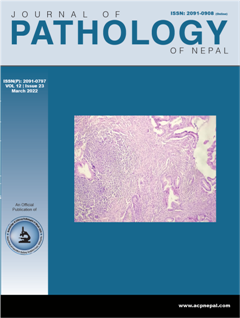Antifungal susceptibility test of biofilm-producing pathogenic Candida albicans isolated from oral cavity of type II diabetic patients and non-diabetic individuals
DOI:
https://doi.org/10.3126/jpn.v12i1.42388Keywords:
Antifungal drug resistance, Biofilm, Candida albicans, Diabetes Mellitus, oral cavityAbstract
Background: Candida albicans are found in the mucous membranes of the respiratory, gastrointestinal, and female genital systems as part of the natural flora. Diabetic people are more susceptible to Candida albicans infections due to elevated blood glucose and the immune system's failure in fungus eradication. This study aimed to look at Candida carriage and antifungal susceptibility testing of biofilm-producing Candida albicans isolated from the oral cavity of type II diabetic patients and non-diabetic individuals.
Materials and Methods: This was a cross-sectional analytical laboratory-based study carried out in Dharan Sub-Metropolitan city from June 2018 to November 2018. The 10 mL oral rinse was collected from 50 diabetic patients and 50 healthy control participants. Isolation, identification, biofilm assay, and antifungal susceptibility test of Candida albicans were performed by the conventional microbiological procedure. Statistical analysis was used to determine the association between variables.
Results: The Candida carriage was significantly higher in diabetic patients 58% (29/50) than in healthy (control) groups 26% (13/50) (p=0.001). In the antifungal susceptibility test of Candida albicans isolated from diabetic patients, 18.75% isolates were sensitive, 81.25% isolates were resistant to fluconazole, 43.75% isolates were sensitive, and 56.25% isolates were resistant to amphotericin-B. The biofilm formation and fluconazole drug resistance were found to be statistically significant (p=0.029).
Conclusions: The findings concluded the highest colonization of oral Candida in diabetic patients than in healthy (control) individuals. Emerging antifungal drug resistance is even associated with biofilm formation, which requires the importance of displaying an antifungal susceptibility profile before antifungal therapy.
Downloads
Downloads
Published
How to Cite
Issue
Section
License
Copyright (c) 2022 Bijay kumar shrestha, Jenish Shakya, Manita Tumbahangphe, Hemanta Khanal, Bidhya Dhungana, Romika Shrestha, Kabita Dhakal, Sujata Chauhan, Santoshi Ghimire, Kaushila Limbu, Jyoti Limbu

This work is licensed under a Creative Commons Attribution 4.0 International License.
This license enables reusers to distribute, remix, adapt, and build upon the material in any medium or format, so long as attribution is given to the creator. The license allows for commercial use.




